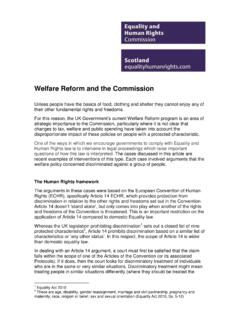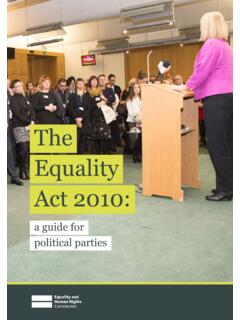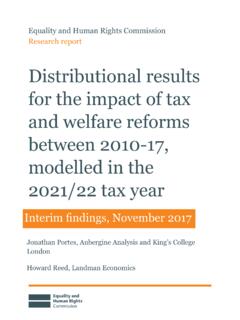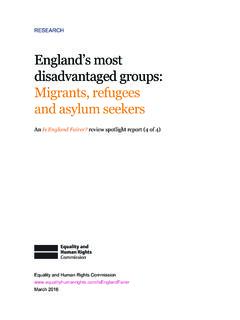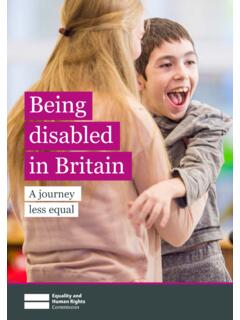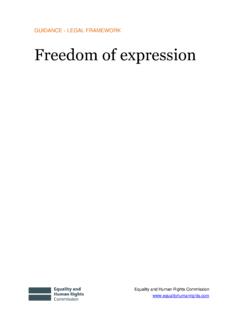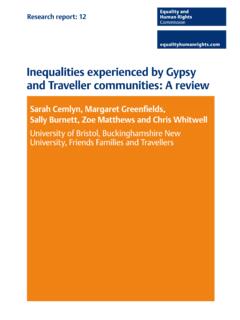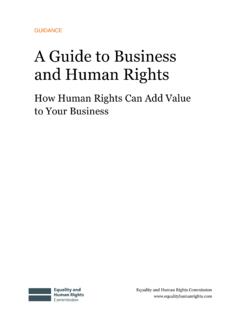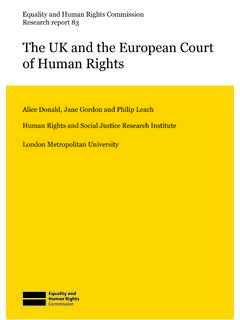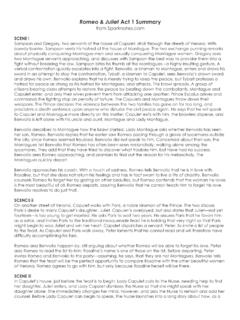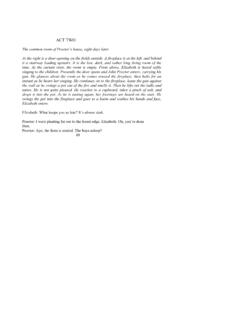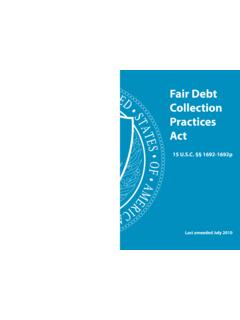Transcription of A critical review of the use of stop and search powers in ...
1 Stop and think A critical review of the use of stop and search powers in England and WalesEquality and Human Rights CommissionForewordAcknowledgementsExecut ive summarySection 1: Introduction Stop and search : what is it good for? The role of the Commission A brief history of stop and search The legal framework The remit of this reportCase study: Ken HindsSection 2: Stop and search statistics Introduction Results using the Ministry of Justice approach Adjusting for ethnic population changes ConclusionsCase study: Staffordshire policeSection 3: Can disproportionality be justified? Street availability Crime rates Data accuracy Effectiveness Discrimination: a continuing problem Policing strategy Conclusion 3458111212151719202224364649505254555656 585860626566686970717374106110 Section 4: Emerging good practice The Next Steps initiativeCase study: Operation PennantSection 5: Conclusion and recommendations The need for real change Particular areas of concern Moving forward Our vision of good enough policingCase study: Cleveland policeAppendix: Statistical tablesEndnotesContactsContentsStop and seeking to protect the rights of the majority, the police at times infringe certain individual rights, such as the right to privacy or to freedom of movement and association.
2 However, they are only permitted to do so if the infringement is rational, proportionate and lawful. Yet the evidence shows that, on the contrary, some police forces are using their powers disproportionately suggesting they are stopping and searching individuals in a way that is discriminatory, inefficient, and a waste of public money. This is despite the evidence from both Staffordshire and Cleveland which proves that a reduction in the use of stop and search can go hand in hand with a reduction in the overall levels of crime. Staffordshire and Cleveland show that policing which respects human rights is more effective and actually makes us safer. The evidence in Stop and think suggests that some forces are exercising their powers not on the basis of intelligence or reasonable suspicion but on stereotypical assumptions, which is not helping to make society safer. Black people are at least six times as likely to be stopped as white people; Asian people, around twice as likely.
3 Such an approach to policing erodes trust and makes co-operation harder, not just between police forces and the groups who are singled out, but also among the wider public, who are ill at ease with the idea of the state intruding unnecessarily into individuals private lives and their freedom to go about their is why the Equality and Human Rights Commission wants to see an end to the disproportionate use of stop and search . We hope to work with the police to make progress through advice, guidance, encouragement, and, where necessary, enforcement. Respecting human rights assists good policing and effective crime control and creates a safer society for us Geraldine Van Bueren, Commissioner, Equality and Human Rights CommissionSimon Woolley, Commissioner, Equality and Human Rights CommissionThe police play a vital role in defending some of our most fundamental human rights. They are guardians of the right to liberty and security, and safeguard the right to life, the ultimate human right.
4 The police support our ability to live free from violence, crime and fear, and help create an environment within which other rights and freedoms can be and think4 AcknowledgementsThis report is the result of the Commission s work to review the disproportional impact of stop and search on black and Asian people in England and would particularly like to thank Professor Ben Bowling, Professor of Criminology and Criminal Justice at King s College London, for taking part in the project and sharing with us his extensive knowledge of research into stop and would also like to thank the following Commission staff for their contributions: Phil Pavey, Policy Manager Justice and Safety, who has worked for many years on these issues; Dr Karen Hurrell, Senior Statistician, who carried out the statistical analysis; Mary Cunneen, Senior Lawyer, for her advice; Dr Marc Verlot, Foresight Director and Head of Criminal Justice and Safety Policy, who took the overall lead of the work; as well as Alice O Keeffe and Rachael Bolden who helped with writing, editing and print production of the summarySection 1: IntroductionThe figures are stark: if you are a black nperson, you are at least six times as likely to be stopped and searched by the police in England and Wales as a white person.
5 If you are Asian, you are around twice as likely to be stopped and searched as a white years of debate and several ninitiatives aimed at tackling the problem, these ratios have stayed stubbornly high. The majority of stops and searches in nEngland and Wales are conducted under the Police and Criminal Evidence Act (PACE). The Commission believes that the current police use of PACE stop and search powers may be unlawful, disproportionate, discriminatory and damaging to relations within and between communities. We will consider taking enforcement naction if we believe police forces are not sufficiently addressing this 2: Stop and search statisticsUsing data from the Ministry of Justice, nthe Home Office, the Metropolitan Police and the Office for National Statistics we have analysed trends in stop and search use around the each force we look at two measures: nthe disproportionality ratio, which tells us how much more likely black and Asian people are to be stopped and searched than white people; and the number of excess searches, which tells us how many more stops and searches are conducted on black and Asian people than would be the case if they were stopped and searched at the same rate as white is a large degree of consistency nover time geographical patterns in the use of stop and search have persisted over many of the highest black/white ndisproportionality ratios are seen in Dorset, Hampshire and Leicestershire.
6 In Hampshire the ratio increased dramatically in 2007 of the highest Asian/white ndisproportionality ratios over the last five years are seen in the West Midlands, Thames Valley, West Mercia and South and Think6 The biggest impact in terms of numbers nof excess stops and searches is seen in London where the stop and search rate is highest at 60 per 1,000 in 2007/08 and where a high percentage of the black and Asian population black stops and searches large nexcesses are also seen in the West Midlands, Greater Manchester, West Yorkshire, Thames Valley, Leicestershire and Asian stops and searches large excesses nare also seen in the West Midlands, West Yorkshire and Thames and/or neighbouring police nareas will often have very different results which cannot easily be 3: Can racial differences in the use of stop and search be justified?Various explanations have been put nforward as to why the police use stop and search powers so disproportionately against certain groups.
7 Even taken together, however, they provide no justification for the extent and persistence of the common explanation, that black npeople are generally more often involved in crime is not supported by robust evidence. In any case, stops and searches should be carried out on the basis of reasonable suspicion . It is unlawful for the police to base their suspicions on generalised beliefs about particular stop and search plays some role in npreventing and detecting crime, the impact is small. It is estimated that searches only reduced the number of disruptable crimes by per cent. Its use therefore needs to be balanced against the negative impact on community confidence in the police if these powers are used differences between similar and/ nor neighbouring police areas indicate that the way a particular police force uses its stop and search powers may be more significant than the nature of the communities it serves. The evidence points to racial ndiscrimination being a significant reason why black and Asian people are more likely to be stopped and searched than white people.
8 It implies that stop and search powers are being used in a discriminatory and unlawful way. Section 4: Emerging good practiceOver the years several initiatives have naimed to tackle this problem. Due to patchy implementation and lack of consistency, however, none has made the necessary lasting impact on rates of disproportionality Next Steps initiative, formulated by nthe National Policing Improvement Agency, and due for roll-out in 2010, may be effective if rigorously implemented and , launching new initiatives is no nlonger enough. The police need to make real improvements that are reflected in the and 5: Conclusions and recommendationsWe are particularly concerned about forces nwith high numbers of excess searches particularly London forces and those with persistently high black/white disproportionality ratios, such as will also be monitoring the figures to nidentify forces in which disproportionality ratios or numbers of excess searches are rising, which has been seen in expect to see improvements within a nyear.
9 If there is little evidence of real change the Commission will consider what further steps it needs to take to effect those forces who have demonstrated nthe most significant and persistent disproportionalities and excesses, we intend to take more immediate action. Following publication, we will be contacting several forces who have demonstrated the most significant and persistent disproportionalities and excesses, with a view to taking enforcement action under the Race Equality Duty, if necessary. It is unrealistic and unhelpful to demand nthat policing should be perfect. We believe, however, that police services should strive to work fairly and effectively while respecting basic human rights. Only then can they be said to be good enough . 1:Introduction9 Since 1995, per head of population in England and Wales, recorded stops and searches of Asian people have remained between and times the rate for white people, and for black people always between 4 and 8 times the rate for white people.
10 And think10 The large majority of searches in England and Wales are conducted under the Police and Criminal Evidence Act 1984 (PACE): around 1 million per year compared to 256,000 in 2008/09 under section 44 of the Terrorism Stop and search under PACE is also used more disproportionately against black people than those conducted under the Terrorism We believe, therefore, that the police use of PACE is of great significance in terms of its impact on community relations. Furthermore, the evidence 5 indicates that PACE may be being used in a discriminatory and unlawful explanations have been advanced as to the extent and consistency of race disproportionality in stop and search , including theories that the data are inaccurate, that black people commit more crime, or that they are more available to be stopped and searched than white people. In this report we examine these arguments and find them inadequate: even taken together, they do not explain or justify the extent and persistence of the problem of race has a huge impact on the experience that people from these groups have of the police: in 2007/08, black people were subjected to around 150,000 more stops and searches the majority of the 172,000 black stops and searches in total than they would have been if they were stopped and searched at the same rate as white the period of more than 10 years over which the statistics have been collected, the ratios have remained stubbornly Despite years of debate and several initiatives aimed at tackling the problem, the police have still not achieved any significant improvement in their record on race disproportionality in stop and search .
